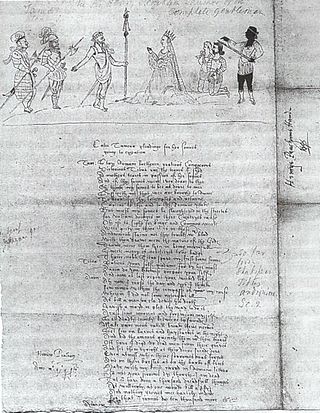
Christopher Marlowe, also known as Kit Marlowe, was an English playwright, poet, and translator of the Elizabethan era. Marlowe is among the most famous of the Elizabethan playwrights. Based upon the "many imitations" of his play Tamburlaine, modern scholars consider him to have been the foremost dramatist in London in the years just before his mysterious early death. Some scholars also believe that he greatly influenced William Shakespeare, who was baptised in the same year as Marlowe and later succeeded him as the preeminent Elizabethan playwright. Marlowe was the first to achieve critical reputation for his use of blank verse, which became the standard for the era. His plays are distinguished by their overreaching protagonists. Themes found within Marlowe's literary works have been noted as humanistic with realistic emotions, which some scholars find difficult to reconcile with Marlowe's "anti-intellectualism" and his catering to the prurient tastes of his Elizabethan audiences for generous displays of extreme physical violence, cruelty, and bloodshed.

The Winter's Tale is a play by William Shakespeare originally published in the First Folio of 1623. Although it was grouped among the comedies, many modern editors have relabelled the play as one of Shakespeare's late romances. Some critics consider it to be one of Shakespeare's "problem plays" because the first three acts are filled with intense psychological drama, while the last two acts are comic and supply a happy ending.
The Master of the Revels was the holder of a position within the English, and later the British, royal household, heading the "Revels Office" or "Office of the Revels". The Master of the Revels was an executive officer under the Lord Chamberlain. Originally he was responsible for overseeing royal festivities, known as revels, and he later also became responsible for stage censorship, until this function was transferred to the Lord Chamberlain in 1624. However, Henry Herbert, the deputy Master of the Revels and later the Master, continued to perform the function on behalf of the Lord Chamberlain until the English Civil War in 1642, when stage plays were prohibited. The office continued almost until the end of the 18th century, although with rather reduced status.

John Payne Collier was an English writer, Shakespearean critic, and forger.
Philip Henslowe was an Elizabethan theatrical entrepreneur and impresario. Henslowe's modern reputation rests on the survival of his diary, a primary source for information about the theatrical world of Renaissance London.

This article presents a possible chronological listing of the composition of the plays of William Shakespeare.

William Henry Ireland (1775–1835) was an English forger of would-be Shakespearean documents and plays. He is less well known as a poet, writer of gothic novels and histories. Although he was apparently christened William-Henry, he was known as Samuel through much of his life, and many sources list his name as Samuel William Henry Ireland.

Locrine is an Elizabethan play depicting the legendary Trojan founders of the nation of England and of Troynovant (London). The play presents a cluster of complex and unresolved problems for scholars of English Renaissance theatre.

Emilia Lanier was the first woman in England to assert herself as a professional poet, through her volume Salve Deus Rex Judaeorum. Attempts have been made to equate her with Shakespeare's "Dark Lady".

Simon Forman was an Elizabethan astrologer, occultist and herbalist active in London during the reigns of Queen Elizabeth I and James I of England. His reputation, however, was severely tarnished after his death when he was implicated in the plot to kill Sir Thomas Overbury. Astrologers continued to revere him, while writers from Ben Jonson to Nathaniel Hawthorne came to characterize him as either a fool or an evil magician in league with the Devil.

John Lowin was an English actor.
Alexander Cooke was an actor in the King's Men and the Lord Chamberlain's Men, the acting companies of William Shakespeare, John Heminges and Richard Burbage.
Samuel Aaron Tannenbaum (1874–1948) was a literary scholar, bibliographer, and palaeographer, best known for his work on William Shakespeare and his contemporaries.
The Woman's Prize, or the Tamer Tamed is a Jacobean comedy written by John Fletcher. It was first published in the first Beaumont and Fletcher folio of 1647, though it was written several decades earlier. There is no doubt that the play is the work of Fletcher alone; his highly distinctive and characteristic pattern of linguistic preferences is continuous through the text.
George Eld was a London printer of the Jacobean era, who produced important works of English Renaissance drama and literature, including key texts by William Shakespeare, Ben Jonson, Christopher Marlowe, and Thomas Middleton.

The Soddered Citizen is a Caroline-era stage play, a city comedy now attributed to John Clavell. The play was lost for three centuries; the sole surviving manuscript was rediscovered and published in the twentieth century.

The Peacham drawing, or 'Longleat manuscript', is the only surviving contemporary Shakespearean illustration, now in the library of the Marquess of Bath at Longleat in Wiltshire. The drawing appears to depict a performance of Titus Andronicus, under which is quoted some dialogue. Eugene M. Waith argues of the illustration that "the gestures and costumes give us a more vivid impression of the visual impact of Elizabethan acting than we get from any other source."
Sir Arthur Mainwaring was an English politician who sat in the House of Commons from 1624 to 1626.

The only surviving image that may depict Anne Hathaway, the wife of William Shakespeare, is a portrait line-drawing made by Sir Nathaniel Curzon in 1708, referred to as "Shakespear's Consort". It was probably traced from a lost Elizabethan original. The drawing is currently located in the Colgate University Libraries, Special Collections and University Archives, Hamilton, NY.
George Turner was an English physician in London. He is known for his interest in alchemy and friendship with Simon Forman. His wife was the convicted murderer Anne Turner.












